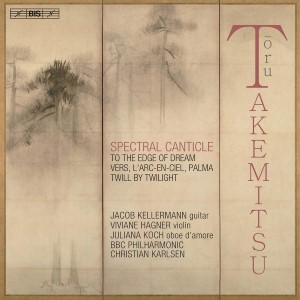
Tōru Takemitsu (1930-1996)
Spectral Canticle for guitar, violin and orchestra (1995)
To the Edge of Dream for guitar and orchestra (1983)
Vers, l’arc-en-ciel, Palma for oboe d’amore, guitar and orchestra (1984)
Twill by Twilight (1988)
Jacob Kellerman (guitar), Viviane Hagner (violin), Juliana Koch (oboe d’amore), BBC Philharmonic/Christian Karlsen
rec. 2022, Philharmonic Studio, Media Centre, Salford, UK
BIS BIS-2655 SACD [54]
What do gardens and rain have in common? Or dreams, twilight, and sky? Such inspirational threads run through the music of Tōru Takemitsu, perhaps Japan’s most iconic composer familiar to the West. It is good to know that people keep revisiting his music a quarter-century after his death.
Spectral Canticle is the longest work here, sixteen minutes (his scores tend to take ten to fifteen). There is the typically sumptuous combination: violin, guitar and a sparingly used orchestra; the generally quiet dynamics add an air of deep mystery. The allusive title may come from Emily Dickinson’s Further in Summer than the Birds, which leads into the sounds and imaginary pictures of the natural world so important to Takemitsu. Crucially, a conventional concept of form is practically impossible to grasp in Takemitsu’s entire output. One should listen to each beautiful moment rather than seek links with earlier material, although they are there. It is like a walk in a Japanese garden (which I was fortunate to do a decade ago) where every step gives a different view and yet everything is the same.
To the edge of dream for guitar and orchestra was inspired by the surrealist Belgian artist Paul Delvaux. His paintings seem to feature rather sinister night-time nude images. Takemitsu’s refined and almost erotic soundworld captures them magically. The guitar, one of the most unassuming of instruments, is delicately balanced within the ensemble, which includes tuned percussion and harp. No fear is evoked, just a slightly troubling dream world. Phrases appear, grow and wither into darkness – a movement, then a fading away.
It can be argued that one of Takemitsu’s pieces goes a long way: the language is consistently similar. I just like to luxuriate in the beauty of the sounds, as in the next piece here, Vers, l’arc-en-ciel, Palma. Again, it features the guitar, this time alongside the oboe d’amore. It was inspired one of twenty-three gouaches by Joan Miró (whom Takemitsu met in 1970). The atmosphere is lighter, and there are even short elements of dance, about five minutes in and about eight. The ending falls into the major tonality, undoubtedly because the composer quotes a Catalan folk song. This is a tribute, says the booklet writer Arnold Whittall, to Alban Berg, whom Takemitsu admired, and his Violin Concerto which quotes a Carinthian folk song. The sounds of Debussy and Ravel are also not far from this Iberian world. Oddly enough, it was first played by the City of Birmingham Symphony Orchestra.
My wife and I like to listen to quiet and thoughtful music to end the day. We choose Takemitsu often, and the last piece on the disc, Twill by Twilight, will be certainly played in the future. It is dedicated to the memory of Morton Feldman, whom Takemistu, perhaps surprisingly, also much admired. The title links the twill, or fabric weaving, and the twilight, “time of day when it seems proper to remember the dead”, as the booklet says. The orchestration, just ‘colour’ and line, is heartfelt, often passionate and highly expressive.
I feel that the performances under Christian Karlsen’s assured direction and the recording are ideal. Of all my discs of Takemitsu’s orchestral works, this will rank at the top.
Gary Higginson
Previous review: David McDade (June 2023)
Help us financially by purchasing from





















